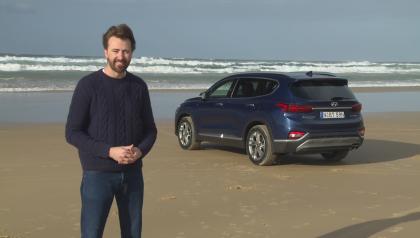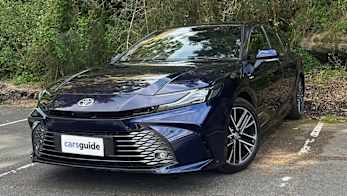The Mitsubishi Outlander is nobody’s first choice for a mid-sized SUV, and the 2WD version even less so. But given the model has remained largely unchanged for three years, the triple diamond must be doing something right. To try and find out what that is, we’ve loaded the second-from-bottom 2WD with a hatch full of camping gear and taken it on a mild off-road adventure to Wombeyan Caves and back, which pitted it against steep and windy gravel roads, wild kangaroos and a family of pigs.
Mitsubishi Outlander 2018: Es 7 Seat (2Wd)
| Engine Type | Inline 4, 2.4L |
|---|---|
| Fuel Type | Unleaded Petrol |
| Fuel Efficiency | 6.8L/100km (combined) |
| Seating | 7 |
| Price From | $14,410 - $18,920 |
| Safety Rating |
|
Is there anything interesting about its design?
Like the ASX below it and the proper Pajero above it (not the sort-of ugly looking Pajero Sport), the Outlander is neither good looking, nor bad, but conservatively designed with enough modern flair to fit in at school pick-up without creating any bold statements or setting new trends.
Although the range is increasingly moving away from its roots as a soft-road 4WD, its maintained that typical SUV body-shape and, for the most part the new-ish front end (which it received in 2015) is one of the best things that’s ever happened to it, and still looks good now.
Inside, the Outlander has a modest flair thanks to small details like white-on-black stitching, a simple centre-dash layout, and use of carbon-fibre-look infills that’s not overdone.
.jpg)
How practical is the space inside?
This isn’t a huge SUV, especially one trying to seat up to seven people, but for all that, the space is used incredibly well. When the second- and third-row seats are folded forward, the floor space is flat from front to back, which makes packing a lot of gear in easy and convenient. What I really like is that the second-row seats can slide forwards, so if you are travelling with a couple of kids and a boot-full of camping gear, you can reduce the amount of leg-room you give them (the only thing kids do with leg-room is drop toys and food crumbs into it, so they don’t need it anyway), to maximise the amount of space you’ve got in the rear load area. And if you’re camping with kids, every skerrick of space counts.
Interestingly, there’s not a lot of benefit in the five-seater when it comes to space. Both it and the seven-seater have the same volume of load-space with all seating rows folded down, while the seven-seater’s only sacrifice to the space is the pair of cup holders for the third-row passengers. However, the seven seater is about 40kg heavier, so those two extra seats do technically affect load capacity.
Does it represent good value for the price? What features does it come with?
As far as value goes, the Outlander is one of the sharpest priced mid-sized SUVs on the block. At just $30,990 it’s cheaper than the equivalent Toyota Rav4, Mazda CX-5, Nissan X-Trail, Kia Sportage and Hyundai Santa Fe, partly because this Outlander’s platform is getting old now, partly because it doesn’t quite have the same safety features in the base models as some of those vehicles mentioned, and partly because Mitsubishi generally keeps its prices sharp.
Still, it is well featured, even on the bottom rung. The ES range offers the choice of two petrol engines, the smaller with a five-speed manual or the bigger with a CVT transmission and the choice of 2WD or AWD drivelines.
All models come with 18-inch alloy rims, LED daytime running lights and tail lamps, roof-rails. and central locking. The front-seat occupants benefit from dual-zone climate control, cruise control, steering wheel stereo and phone controls, a couple of USB points, and a touch-screen centre display with Apple and Android phone integrations. There’s no built-in mapping, though, so if you’re out of phone service areas regularly, it could be an issue.
.jpg)
What are the key stats for the engine and transmission?
There are three engines offered across the Outlander range, although automatic 2WDs are only available with a 2.4-litre four-cylinder petrol. It’s capable of 124kW at 6000 rpm and 220Nm of torque at 4200rpm. The only transmission option with this engine is a CVT.
.jpg)
How much fuel does it consume?
Loaded up with camping gear and following the winding and unsealed backroads of the Southern Highlands, the Outlander used 29.2 litres of fuel over 376 kilometres, which is just shy of 7.8L/100km. Mitsubishi claims a combined consumption of 7.2L/100km under more controlled circumstances, so that’s a good figure. The tank can hold 63 litres of fuel, so expect the range to be around 750km to a tank.
What's it like as a daily driver?
Similar to the Outlander's looks, it’s neither good nor bad. I almost want to call it boring to drive, but it’s not quite that either. Let’s just call it adequate as a daily driver.
The Outlander is comfortable and quiet on the road. It has no rattles and very little engine or road noise intrudes into the cabin. Under acceleration it’s definitely not sporty, but it’s not slow either. If you need to put the boot in, it’ll respond well enough.
.jpg)
The steering is a little twitchy, especially trying to keep it in a straight line on the highway. That’s likely thanks to the electronic power steering, which isn’t as fluid in its assistance as the older-tech hydraulic systems are. The benefit, of course, is better fuel consumption, but I did find it a little hard to get used to.
With the reverse camera and small stature, the Outlander behaves like a largeish hatch if it’s used around the shops or to cart kids to and from school. The middle-row seats are easy to move forward to give access to the third row. However, those back seats don’t have a lot of space in them – they’re probably better left for special occasions, or as regular seats for your kids’ friends who you’d rather weren’t their friends.
What's it like for touring?
With a family of seven, there’s no way you could tour in this – buy a bus. But for just two or three people, there’s a lot to be said for this medium SUV. As a comfortable daily driver fitted with cruise control and climate control, it’s good for long days in the saddle, while the modulation of the seats and storage areas helps make the most of what space it does have.
Given the nature of travel most likely to be undertaken by the Outlander, you’d struggle to convince me of the need to part with the extra cash for the AWD version, though. Unless I was regularly travelling to the snow fields (and didn’t want to have to worry about chains all the time) or lived near an easily accessible beach, there’s not much the 2WD can’t do.
.jpg)
It did struggle for traction a little on unsealed corners, or if ever I need to do a hill start on gravel, plus was prone to some bump steer on rougher roads. It was otherwise well behaved off the bitumen, but I’d hesitate to tackle a really rough road in it.
It’s capable of towing up to 1600kg, which puts it in the range of many camper trailers, and even some small caravans, but in real terms, 1600kg of weight hanging off the back is going to be hard work for the capacity of the engine and CVT transmission.
Warranty & Safety Rating
What safety equipment is fitted? What safety rating?
The Mitsubishi Outlander was awarded a five-star ANCAP safety rating on its updated release in 2015. It has dual front, curtain, and driver knee airbags, plus the essential suite of electronic safety aids, including ABS, EBD, ASC, ATC and ESC. Hill start assist is across the range, as is Emergency Stop Signal Function (where the brake lights flash under heavy braking) and a reversing camera. Next models up get reversing sensors, adaptive cruise control, and a forward collision mitigation system and lane departure warning.
What does it cost to own? What warranty is offered?
The Outlander is covered by Mitsubishi’s capped price servicing scheme. The cost of a service is only $280 for and you’ll only need one every 15,000km or 12 months, whichever comes first. That’s a slight increase on the 2017 models, though, which will be serviced for just $230 for the first three years.
Major pain points will come at 90,000km when the iridium or platinum tipped spark plugs need to be replaced along with all the engine and transmission fluids, but otherwise service intervals are generally long and well-spaced.
Mitsubishi offers a 5 year/100,000km warranty, plus 5 year Perforation Corrosion Warranty on the Outlander.
Verdict
The 2WD Outlander is a tidy package that’s a long way from the most impressive among its peers, but also the one that doesn’t really do anything wrong. It’s good looking without being over the top, has reasonable internal space that’s quite versatile, plus is comfortable to drive in most situations.
This is certainly not the SUV for long-distance outback adventures (and neither is the AWD version, really), but it’s more than capable of getting out into the real Australia and exploring its back roads and campsites, even with a small family on board.
What do you think of the 2WD Outlander? Tell us in the comments section below.
Pricing Guides







.jpg)
.jpg)
.jpg)
.jpg)

.jpg)
.jpg)
.jpg)
.jpg)
.jpg)
.jpg)










.png)








.jpg)

.jpg)



